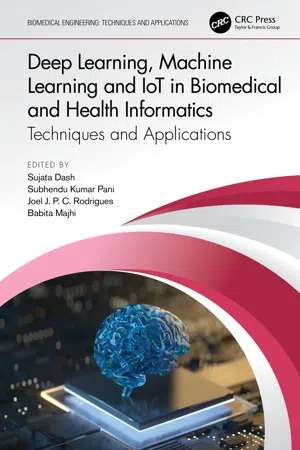
Deep Learning, Machine Learning and IoT in Biomedical and Health Informatics
Techniques and Applications
Sujata Dash, Subhendu Kumar Pani, Joel J. P. C. Rodrigues, Babita Majhi, Sujata Dash, Subhendu Kumar Pani, Joel J. P. C. Rodrigues, Babita Majhi
- 362 pages
- English
- ePUB (adapté aux mobiles)
- Disponible sur iOS et Android
Deep Learning, Machine Learning and IoT in Biomedical and Health Informatics
Techniques and Applications
Sujata Dash, Subhendu Kumar Pani, Joel J. P. C. Rodrigues, Babita Majhi, Sujata Dash, Subhendu Kumar Pani, Joel J. P. C. Rodrigues, Babita Majhi
À propos de ce livre
Biomedical and Health Informatics is an important field that brings tremendous opportunities and helps address challenges due to an abundance of available biomedical data. This book examines and demonstrates state-of-the-art approaches for IoT and Machine Learning based biomedical and health related applications. This book aims to provide computational methods for accumulating, updating and changing knowledge in intelligent systems and particularly learning mechanisms that help us to induce knowledge from the data. It is helpful in cases where direct algorithmic solutions are unavailable, there is lack of formal models, or the knowledge about the application domain is inadequately defined. In the future IoT has the impending capability to change the way we work and live. These computing methods also play a significant role in design and optimization in diverse engineering disciplines. With the influence and the development of the IoT concept, the need for AI (artificial intelligence) techniques has become more significant than ever. The aim of these techniques is to accept imprecision, uncertainties and approximations to get a rapid solution. However, recent advancements in representation of intelligent IoTsystems generate a more intelligent and robust system providing a human interpretable, low-cost, and approximate solution. Intelligent IoT systems have demonstrated great performance to a variety of areas including big data analytics, time series, biomedical and health informatics. This book will be very beneficial for the new researchers and practitioners working in the biomedical and healthcare fields to quickly know the best performing methods. It will also be suitable for a wide range of readers who may not be scientists but who are also interested in the practice of such areas as medical image retrieval, brain image segmentation, among others.
• Discusses deep learning, IoT, machine learning, and biomedical data analysis with broad coverage of basic scientific applications
• Presents deep learning and the tremendous improvement in accuracy, robustness, and cross- language generalizability it has over conventional approaches
• Discusses various techniques of IoT systems for healthcare data analytics
• Provides state-of-the-art methods of deep learning, machine learning and IoT in biomedical and health informatics
• Focuses more on the application of algorithms in various real life biomedical and engineering problems
Foire aux questions
Informations
Part I Machine Learning Techniques in Biomedical and Health Informatics
1 Effect of Socio-economic and Environmental Factors on the Growth Rate of COVID-19 with an Overview of Speech Data for Its Early Diagnosis
- 1.1 Introduction
- 1.1.1 Motivation and Research Objective
- 1.2 Databases and Socioeconomic, Environmental Features
- 1.2.1 Temperature (f1)
- 1.2.2 Happiness Index (f2)
- 1.2.3 Cleanliness Index (f3)
- 1.2.4 Gross Domestic Product (f4)
- 1.2.5 Pollution Index (f5)
- 1.2.6 Number of Caregivers/Nurses per 1000 People (f6)
- 1.2.7 Number of Physicians per 1000 People (f7)
- 1.2.8 Diabetes Prevalence (f8)
- 1.2.9 Population Aged over Sixty-five (f9)
- 1.2.10 Smokers above Age Fifteen (f10)
- 1.3 Growth Rate Calculation and Feature Selection
- 1.3.1 Growth Rate Calculation
- 1.3.2 Feature Selection
- 1.4 COVID-19 Speech Analysis
- 1.5 Conclusion
- References
1.1 Introduction
1.1.1 Motivation and Research Objective
- Calculation of the growth rate of COVID-19 for different countries and classification of them into the low, medium, and high categories.
- Preparation of the Socioeconomic and Environmental factors based on the data set of different countries.
- Application of feature selection algorithms to identify the importance of each of these factors on the growth rate of COVID-19
- Analysis of different techniques and databases used for Non-invasive COVID-19 detection using speech signals
1.2 Databases and Socioeconomic, Environmental Features
| Sl. No | Feature Name... |
|---|
Table des matières
- Cover Page
- Half Title Page
- Series Page
- Title Page
- Copyright Page
- Contents
- Preface
- Acknowledgements
- Editors
- Contributors
- Part I Machine Learning Techniques in Biomedical and Health Informatics
- Part II Deep Learning Techniques in Biomedical and Health Informatics
- Part III Internet of Things (IoT) in Biomedical and Health Informatics
- Index